The best pet cameras in 2024, tried and tested
Content is created by CNN Underscored’s team of editors who work independently from the CNN newsroom. When you buy through links on our site, CNN and its syndication partners may earn a commission. Learn more
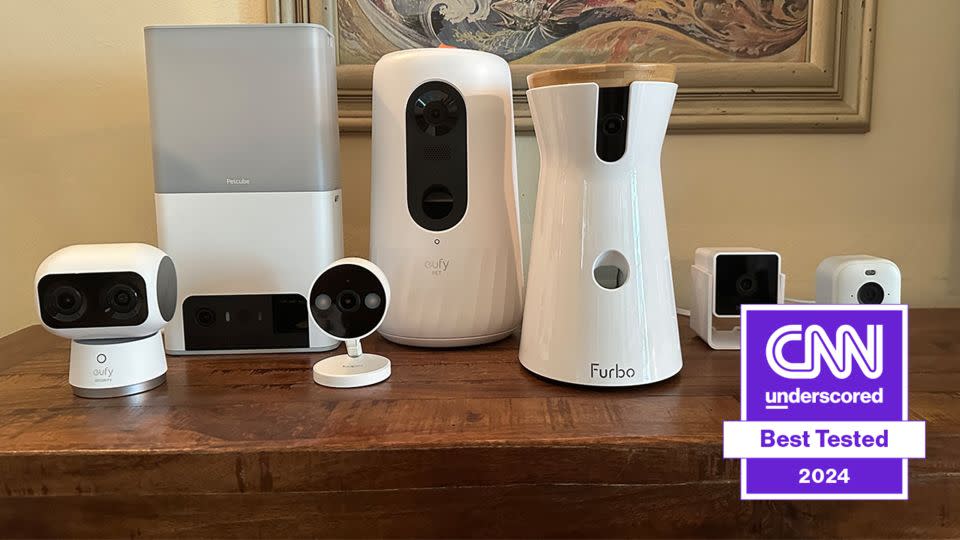
If you’re curious about what your dog or cat gets up to when you’re away, a dedicated pet camera could be a great investment. When positioned in your living room (or whichever room your pet spends the most time), these cameras provide a live video stream to a smartphone app, as well as a variety of pet-focused interactive features. Depending on the model, you can customize motion and audio sensors that notify you when it’s activated, communicate with an anxious pet via two-way audio and even toss prefilled treats at the push of a button.
To better understand how they work, and ultimately find the best pet camera, I sourced the seven most popular models for review. I enlisted the help of my dogs for a comprehensive testing process that compared each option based on usability, functionality, footage storage and video capabilities. In the end, I found two that are worth your money.
TP-Link Tapo C120 2K
Best pet camera
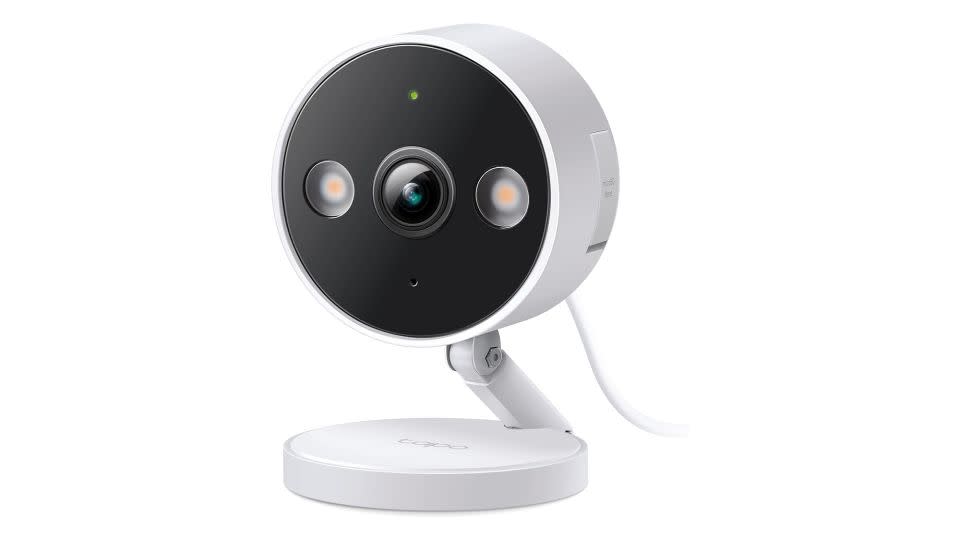
Affordable, nonintrusive and simple to use, the Tapo C120 is a convenient option for pretty much any pet owner. The 2K video quality provided a clearer image than all but one of the models we tested, making it a superb value for the price.
Furbo 360° Dog Camera and Treat Dispenser
Best splurge pet camera
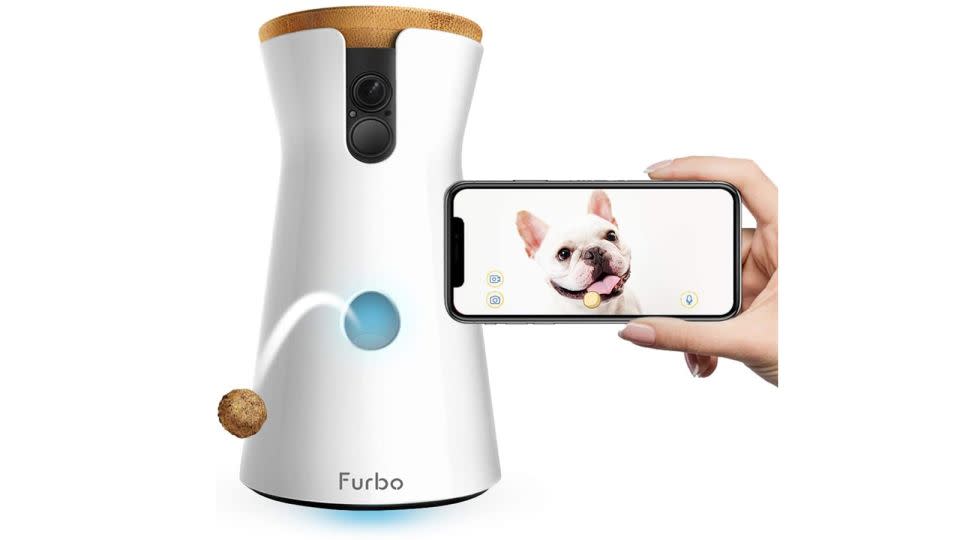
It’s not cheap but with a rotating base for maximum room coverage, an interactive treat tosser and a user-friendly app, the Furbo 360° provides the most functionality out of all the cameras we tested.
Best pet camera: TP-Link Tapo C120 2K
$40 $30 on Amazon
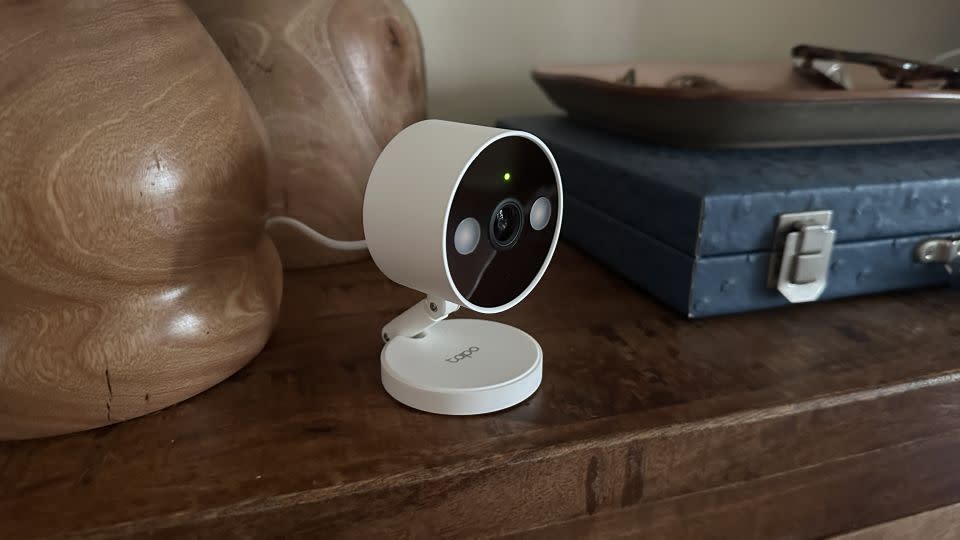
Packed with useful features and boasting a surprisingly sharp 2K image, this compact camera provides a ton of functionality at a budget-friendly price. Setting up the TP-Link Tapo C120 2K is about as easy as it gets too, and the Tapo app walks you through the entire connection process in a few minutes. With a 2.25-inch-diameter footprint (only the Blink Mini 2 took up less space), magnetic base and flexible neck, this camera is also convenient to position or mount almost anywhere.
The app provides a responsive live feed of the camera (just a second or two delay from real time), with large icons for functions like taking a photo, starting a recording, toggling privacy mode and utilizing two-way audio. Although it wasn’t crystal clear (none of the models I tested had perfect audio quality), I had no trouble understanding audio from the camera or phone speakers.
The TP-Link Tapo C120 2K also provides a wide range of motion (person, pet, vehicle) and sound (dog barking, cat meowing, glass breaking) alerts to select. You can adjust the sensors’ sensitivity and toggle them on or off depending on your preference. For even more customization, you can create specific activity or privacy zones within the camera frame. Whenever your preferred alerts are activated, a push notification is sent to your phone, allowing you to watch footage of the automatically recorded event. Quickly locating these settings within the app takes a little practice at first, but after about an hour, it was second nature.
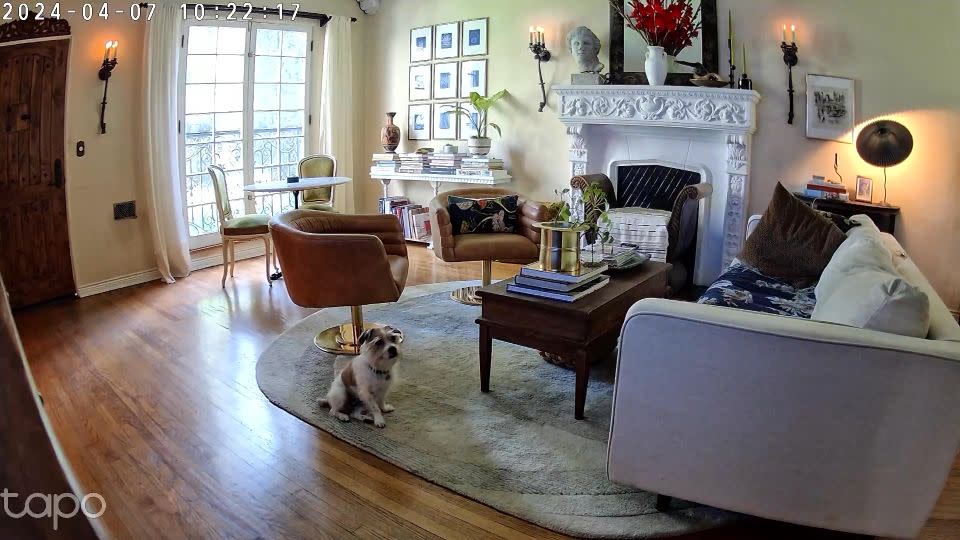
The biggest factor that separates the TP-Link Tapo C120 2K from other cameras (particularly lower-priced models) is its impressive video quality. Its 2K definition is significantly sharper than the 1080p picture of the similarly- priced Petcube Cam Indoor and Blink Mini 2, and combined with the pinch-to-zoom capability, it really lets you see what’s happening in your space. I also found the night vision to be sharper than almost every other model I tested, and optional spotlights can be activated for immediate illumination.
Footage can be stored locally (up to 512 GB microSD card), or on the cloud using a Tapo Care subscription plan. The basic plan costs $3.50 monthly and provides 30 days of cloud storage. The TP-Link Tapo C120 2K doesn’t have the treat-tossing or rotating capabilities of some higher-end options but if those aren’t your top priority, the compact size, clear picture and variety of detection settings make this camera a fantastic option.
Best splurge pet camera: Furbo 360° Dog Camera
$210 on Amazon
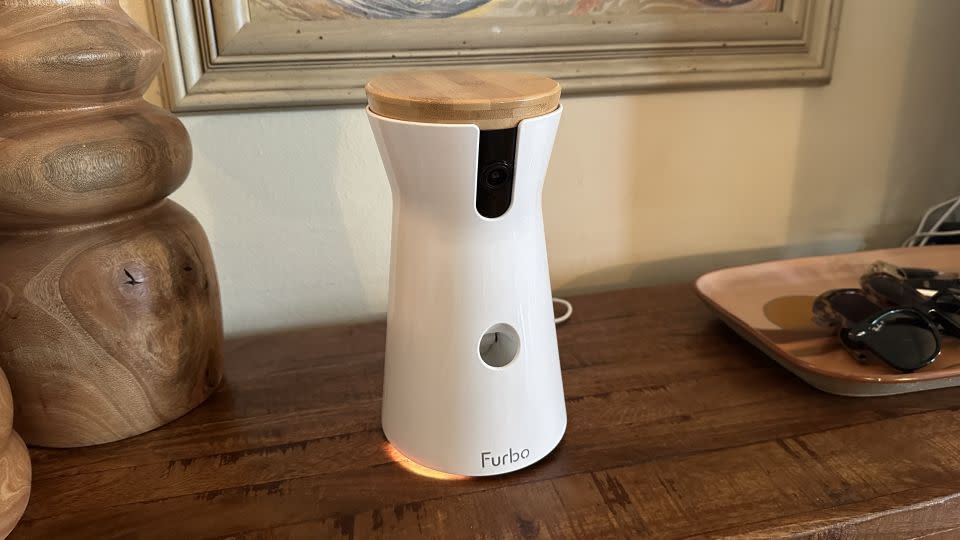
If you have the budget and a treat-tossing model is a priority, the Furbo 360° is a solid option. Setup is a breeze — the Furbo app holds your hand through the entire connection process — and although this model is bulkier than compact options, it still only takes up a little more than 5 inches of space. The hourglass shape also creates a less intrusive profile than the other treat-tossers I tested. I also appreciate how the power cord can be used with the regular two-prong plug or USB, making it convenient to use with power strips that have both.
Using the treat-tossing feature of the Furbo 360° is simple too. You fill up the canister with your treats (1/2-inch size is recommended) and swipe the treat icon on the app’s live feed. You can also select your treat size, either small (less than 1/2 inch) or large (1/2 to 3/4 inch) to maximize treat-tossing effectiveness, and also record your audio to play before the treat is launched. In the rare event any treats got clogged or jammed together, the soft rubber flippers that transitioned each treat from the canister to the launcher did a great job of fixing the problem, automatically reversing and resuming their rotation until the jam cleared.
The Furbo 360° is also capable of differentiating between people and animals and uses its 360-degree camera to track your pet as it roams the room. One of my favorite features of this camera is your ability to remotely rotate the camera whenever you want. Directional arrows on either side of the live video feed make it easy to pan the room, which I found to be especially useful for locating a sleeping dog in the afternoon.
The variety of alerts is useful and easy to customize to your needs, and adjusting the volume and sensitivity of them is simple to accomplish on the app — although without a subscription, you’re limited to barking alerts only. With a Furbo Nanny subscription, you get additional AI smart alerts like activity, crying/whining, person alert, smoke alarm, carbon monoxide and glass breaking. These could be useful if you have a big dog that knocks a lamp over, allowing you to return home quickly before they accidentally cut themselves. Or be notified of a house fire when the smoke alarm is activated. After a 90-day free trial, a Furbo Nanny subscription runs you $6.99 per month or $69 per year.
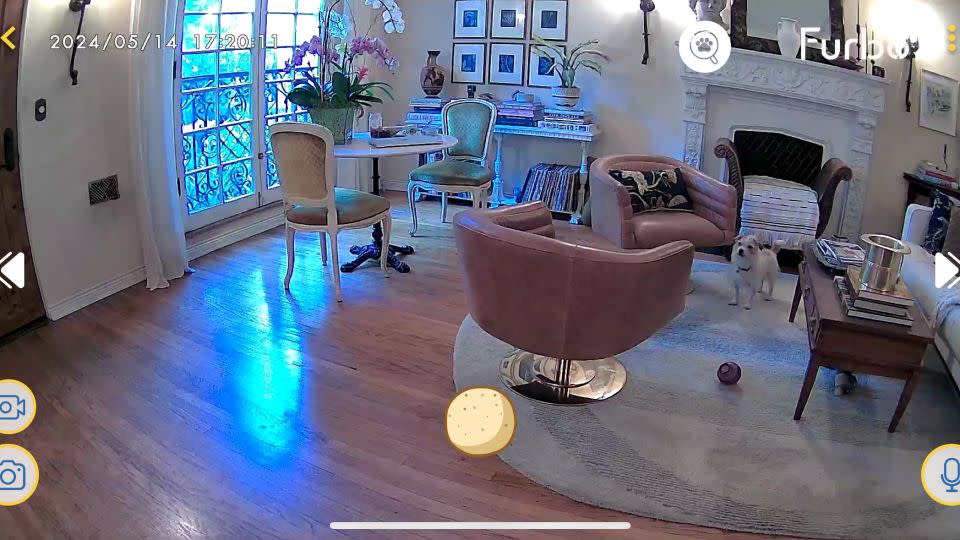
It’s not cheap but if you’re interested in a pet camera with all the bells and whistles and don’t mind the higher-than-average price tag, look no further than the Furbo 360°.
Do I need a pet camera?
Monitoring your pet when you’re not around is useful in several ways. First, it allows you to observe and diagnose behavior you may not be aware of — barking at the mail person, whining and scratching at the door or jumping on the dining room table — and take the necessary steps to treat and manage that behavior. Most pet cameras have specific motion and sound sensors you can customize to alert you when these actions occur and automatically record them to view later. These are especially useful for showing to a prospective dog trainer or behaviorist before deciding on a training plan. These notifications also give you the peace of mind that if anything happens when you’re not home — whether that’s an intruder breaking in or your dog accidentally knocking a glass vase onto the floor — you’ll be alerted and able to react immediately.
Another use of a pet camera is how it lets you interact with your pet while you’re away. These features differ from typical security cameras and are typically interactive, like two-way audio or treat-tossing. They allow you to redirect or distract your pet from bad behaviors and calm or reprimand them if applicable.
What features should I look for in a pet camera?
Pet cameras provide many different features, so it’s important to choose one that’s the best fit for you and your furry friend.
If interacting with your pet is a high priority, look for a camera with two-way audio capability and/or a treat dispenser. Two-way audio allows your pet to hear your voice, which can help ease separation anxiety (although some behaviorists warn that hearing your disembodied voice can cause confusion and more stress), or the boredom that can lead to destructive behaviors like chewing, carpet digging or howling. For instance, you can use two-way audio to verbally correct your dog upon receiving an excessive barking alert. An integrated treat dispenser can be an even more effective method of distraction, allowing you to reward your dog for complying with specific commands, keep them fed, practice obedience commands or provide mental stimulation to stave off boredom.
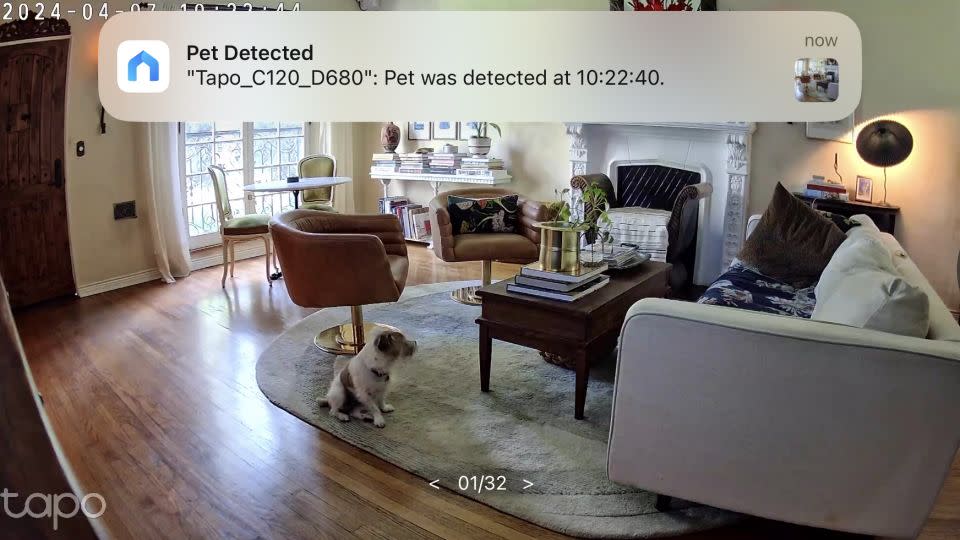
If you’re more interested in hassle-free operation, look for cameras that can be set to turn on and off at a preset schedule and offer a variety of motion and alert settings. This allows you to set it up once and not worry about turning it on and off every time you leave the house. Specific settings also prevent you from getting dozens of alerts and recordings you don’t care about.
You should also consider the size and shape of the pet camera, and make sure it fits in the area you plan on keeping it. If you don’t have much surface space to spare, consider a camera that can be mounted to the wall or underneath a shelf.
Since all pet cameras use a smartphone app to view the footage, ensure the model you’re considering is compatible with your phone and current operating system. Also, if you plan on using your pet camera with a smart home hub, make sure that the model is compatible with the brand you have.
How we tested
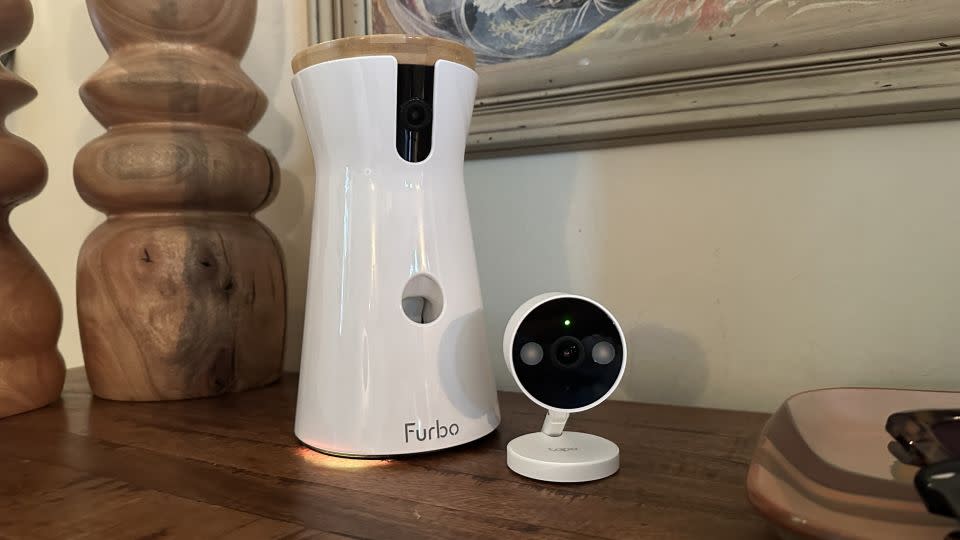
To fully understand each model’s capabilities and confidently comment on its performance, I ran each pet camera through a complete testing and evaluation process.
Usability
Setup: I evaluated how easy the cameras were to set up and power on out of the box, and the effectiveness of any included instruction manuals. I noted any issues with downloading and connecting to the mobile app.
Placement: I evaluated how their physical dimensions, shape and weight affected positioning, and made sure to note each model’s mounting options (some have the added option of wall or under-shelf mounting).
App operation: While using each camera in my living room for several days and using it to monitor my two dogs when I left the house, I explored all available video, audio and treat-tossing features through the app. I paid close attention to how convenient the app was to use —– from receiving a sensor notification on my phone to watching the footage —– and if the process felt streamlined or overly complex and inconvenient.
Functionality and performance
Video quality and coverage: To compare each camera’s video quality, I took screenshots of the live feed and zoom stills (in day and night-vision mode), which I then compared side by side when I was finished. This allowed me to accurately compare each camera’s video quality, as well as notice differences in field of view and lens coverage.
Interactive features: For treat-tossing cameras, I launched dozens of treats over several days, evaluating how easy it was to access the function and noting any customizable features like tossing distance or custom sounds to get your dog’s attention. I also compared their assembly and refill processes, and if they were easy to keep clean when empty. I also used any available two-way audio features to listen to and communicate with my dogs, noting any obvious audio quality or delay issues.
Remote control features: I explored any other remote features offered, such as rotating and tilting camera heads, or spotlights for added night vision.
Footage storage: I also researched each camera’s footage storage options and limitations, comparing factors like clip length, overwrite timeline and timestamps, and if they offered local and cloud-based storage.
Subscription commitment: All the pet cameras I tested offered subscription plans for cloud storage (apart from the onboard storage of the Eufy Security Pet Camera), so I compared each brand’s pricing plans and features provided with each tier.
Other pet cameras we tested
Petcube Bites 2 Lite
$105 on Amazon
This treat-tossing camera boasts a spacious container and user-friendly controls, making it a fine budget-friendly alternative to the Furbo 360°. The Petcube app is easy to figure out and simple to use, and the oversized treat icon is convenient to tap and launch treats. I also appreciate how, if sharing the camera feed with friends or family, you can limit the number of treats dispensed, and avoid accidentally overfeeding your pet. The fixed base lacks the rotating ability of the Furbo 360° and Eufy Security Pet Camera models, though, and despite the flat shape being convenient for wall mounting, it’s less stable on a flat surface than circular treat-tossers. Live streaming and treat-tossing are available without a subscription, and the Petcube “Optimal” plan ($48 annually or $7 monthly) provides smart alerts that can distinguish between barks, meows and other sounds and/or motions; 30-second video clips; and up to 10 video downloads per month.
Petcube Cam Indoor
$35 on Amazon
This relatively bare-bones option could be a good fit for those who don’t have the need or budget for a higher-end model. The camera tilts up and down inside a sturdy square base (although not automatically), so whether it’s placed on a countertop, underneath a shelf or mounted on a wall, you can adjust the angle to create the best camera frame for your space. This mounting versatility makes the Petcube Cam Indoor an attractive option for those who don’t have much available surface space. The 110-degree lens provided the most limited view during testing, though, and the night-vision capabilities were also blurrier than most. The Petcube app allows you to customize the motion and sound alerts sent to your phone, though just like the Petcube Bites 2 Lite, a $48 annual (or $7 monthly) subscription is required to access these alerts. If you prefer not to pay for a subscription, this camera only provides live video streaming.
Blink Mini 2
$40 $30 on Amazon
This tiny camera isn’t specifically designed for pets, but with motion-detection capabilities, two-way audio and a live feed, it’s still an effective option for keeping an eye on your furry friend. Setting up the camera and connecting to the Blink app was a breeze, and with a 2.25-inch-diameter footprint, it’s convenient to place pretty much anywhere (it also includes hardware for wall mounting). The 1080p image quality matched the majority of the cameras I tested (only the Eufy S350 and TP-Link Tapo C120 2K offered higher resolution), and the 143-degree field of view provides a nice wide coverage area (a big improvement over the 110-degree angle of the previous Blink Mini model). This camera also has motion-activated notifications and five minutes of live streaming without a subscription, making it a great option for those who don’t need a lot of bells and whistles.
Eufy Security Indoor Cam S350
$130 on Amazon
With a dual-camera layout — a 4K wide-view lens and 2K telephoto for zoom — this Eufy camera delivered exceptionally crisp and clear image quality, superior to the other options I tested. Thanks to its smart-tracking technology and a head that pans and tilts (no other camera I tested could adjust vertically), it does a great job keeping your pet in frame as it moves around. You can also control the viewing angle via the app by using directional arrows on the live-view feed. The Eufy app isn’t the easiest to use, though, and while it’s packed with useful settings and control options, this does make it a little cluttered and less user-friendly than more basic options. This model is pricey, but it does offer the option to utilize local storage instead of cloud recording, which requires no subscription. Local storage also has the advantage of recording in 4K, whereas cloud storage image quality is limited to 2K.
Eufy Security Pet Camera
$200 $130 on Amazon
It’s not cheap but if you’re looking for a treat-tossing camera with lots of bells and whistles, this Eufy model could be worth the investment. Its 360-degree rotating base automatically tracks your pet as it wanders, and you can even rotate the camera yourself in the app’s live feed (the Furbo 360° is the only other camera capable of on-demand rotation). Treat dispensing is done easily by swiping the cookie icon, and its anti-clog design works effectively. The treat canister can also be removed for cleaning, and I appreciated that the treats don’t ever come in contact with the gears that spin the launchpad, keeping them clean and working smoothly. Although this camera lacks a cloud storage option, it does have 16GB of local storage and doesn’t require a monthly subscription, which justifies the high upfront cost. At nearly 6 inches in diameter, 12.44 inches tall and a hefty 3.23 pounds, the Eufy is the largest model I tested. If you have the space for it and prefer local over cloud storage, the Eufy Security Pet Camera is a great runner-up to the Furbo 360°.
Note: The prices above reflect the retailers' listed price at the time of publication.
For more CNN news and newsletters create an account at CNN.com

